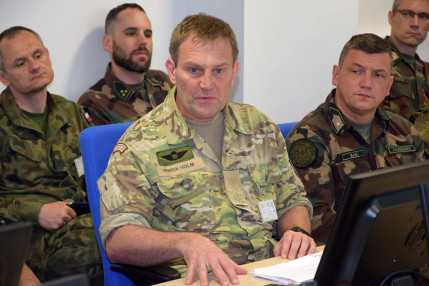The joint training of the Operational Liaison and Reconnaissance Team (OLRT) of the Multinational Corps Northeast (MNC NE) and NATO Force Integration Unit Hungary (NFIU HUN) has come to an end, in the course of which the experts of the direct NATO Superior Command of the Hungarian organisation could successfully establish and enhance professional contacts not only with NFIU HUN, but with certain units of the Hungarian Defence Forces, as well as with different governmental and civil organisations.
During their stay in Hungary, the OLRT members could acquire detailed information about the processes taking place in our country, about the military and civil capabilities available, which contributes to obtaining a comprehensive picture. In the event of a crisis, the smooth co-operation between the incoming NATO Response Force (NRF) and the host nation is of priority importance, and its promotion and the related co-ordination is the main task of NFIU HUN.
The regular exercising of the close co-operation with NATO military components, such as OLRT constitutes an integral part of the tasks of NFIU. In the past few days one of the core tasks of NFIU HUN has been enabling the OLRT to establish good working contacts with the different Hungarian military and civil actors, and providing them with the technical conditions for reporting their experiences to MNC NE.
The days spent in Hungary meant a busy program for the OLRT members. Following the mutual briefings, reports at NFIU, one half of the group at first visited HDF 25th “Klapka György" Infantry Brigade from among the Hungarian units playing a priority role in the host nation support, where they got acquainted with its history, structure, main tasks and mission, and could view the equipment of the unit. The Tata Brigade has been closely co-operating for years with the different allied military components, and takes part in joint exercises on a regular basis. Their experiences acquired during these events and their military capabilities available play a key role not only in the constant development of our own national capabilities and readiness, but also in the preparation for the defence tasks affecting the whole of the country and of the alliance.
When receiving NATO Response Force coming by air to Hungary, an equally important role is due to the airport with the proper capabilities, which is appropriate for receiving and handling the teams, and also the bulk equipment. These requirements are met by the HDF Pápa Air Base, which functions as the base of NATO SAC (Strategic Airlift Capability) as well, where over recent years major developments have been carried out thanks to the NATO Security Investment Program. During the on-site visit of the Base, the OLRT members could view the investments already completed, such as the new passenger terminal, meeting all requirements, and could also get an idea about the further development projects to be implemented in the future.
Parallel to the visits paid to the military units, another group of the OLRT experts participated in the meetings organised with the representatives of the Hungarian-based international, non-governmental and governmental organs, among them the United Nations High Commissioner for Refugees (UNHCR), the Hungarian Red Cross and with experts of the various ministries. During the meetings with the leaders, prepared by NFIU HUN, the negotiations covered subjects of mutual interests, such as the prospects of the future co-operation of MNC NE and the UNHCR in Central Europe. As a result of the mutual exchange of information good relationships developed between NATO HQ and the representatives of the organisations operating in Hungary, which allows OLRT to contact immediately and directly these organisations, if needed. The discussions with the representatives of the ministries and governmental organs in charge of certain defence tasks provided an excellent opportunity for the review of the joint response capabilities and for the discussions about the co-operation. During the visit the Hungarian governmental Crisis Management Centre was also shown to the OLRT members.
Similarly to the other NATO exercises and trainings, the relocation of OLRT to Hungary encouraged the strengthening of interoperability, and acted as a good symbol of NATO’s extended military capabilities, and its efforts for guaranteeing the security of the Member States and the region.
The joint training provided an excellent opportunity for NFIU HUN to demonstrate their own capabilities, which are necessary to accomplish their mission, that is, to facilitate the quick and efficient deployment of NATO VJTF and other high readiness NRF components.






